Feature
A Cancer Education Curriculum for Underserved Elementary School Children
Connected Science Learning October-December 2018 (Volume 1, Issue 8)
By Dieuwertje J. Kast, Anupam Singh, and W. Martin Kast
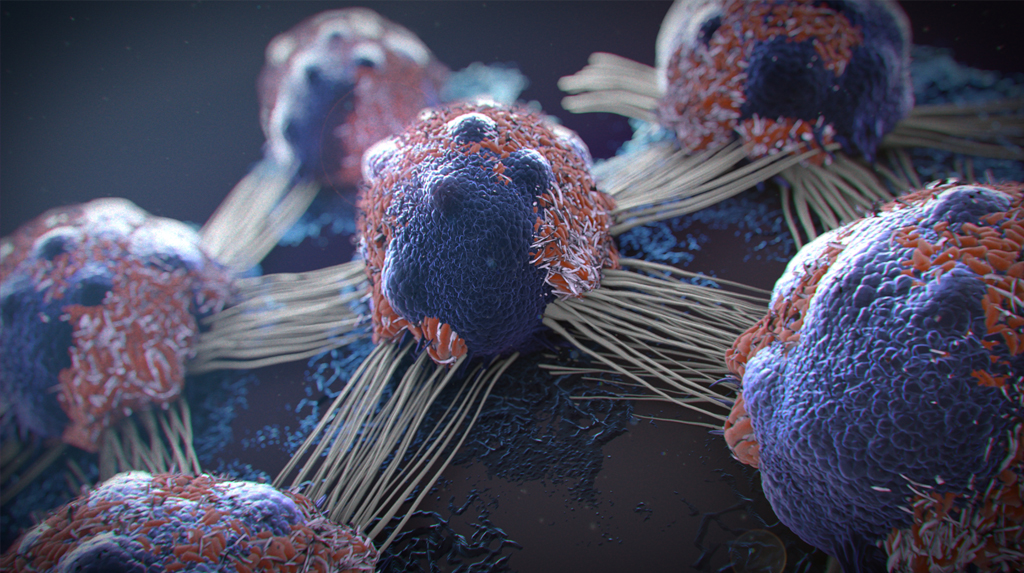
Learn how Los Angeles educators implemented a new curriculum to teach underserved elementary students about basic cancer concepts.
In spring 2018, the University of Southern California’s (USC) Joint Educational Project (JEP), piloted through its ReaderPlus Wonderkids program a new curriculum (also available in Spanish) targeting underserved elementary school children in the Los Angeles Unified School District (LAUSD). The curriculum, developed for a Cancer Education Partnership Program (CEPP) from USC’s Norris Comprehensive Cancer Center (NCCC), focuses on providing first through third graders with a fundamental understanding of various aspects of cancer to reduce fear and anxiety related to the disease. Youth participants were introduced to the scientific background and cutting-edge technologies in the field of oncology through a series of modules focused on general oncology, the genetics of cancer, biotechnology and cancer, and nutrition as part of cancer prevention. The modules created a positive environment for students to creatively think and learn about this leading cause of morbidity through engaging activities, interactive games, and modern technology. We believe that this CEPP curriculum will foster scientific thought among students and their families, encourage open discussions about the biological and social ramifications of cancer, and promote healthy lifestyle choices, all while introducing new perspectives that may ultimately entice young children to consider a future career in the sciences, particularly in oncology.
Most cancer awareness programs traditionally target adults and populations considered to be at risk for developing cancer. Consequently, little attention has been given to educating younger populations about cancer. To address this gap in childhood education, NCCC established CEPP, an umbrella program specifically targeting underrepresented racial and socioeconomic minority (URM) students in grades K–12.
The National Cancer Institute (NCI) defines cancer as “diseases in which abnormal cells divide without control and can invade nearby tissues” (2018). Cancer has long been perceived as a family of diseases that afflicts the elderly or people who practice unhealthy lifestyles. However, genetic predisposition to certain types of cancer can put otherwise healthy and young individuals at significant risk of developing cancer during their lifetime. The unpredictable and seemingly unavoidable nature of the disease instills a fear of cancer in the public and creates a misperception that cancer diagnoses are often terminal. In fact, the variety of diagnoses and outcomes in the treatment of cancer make this assumption a gross oversimplification. Technological advancements, such as gene therapy and immunotherapy, have improved the precision of disease treatment options and improved the prognosis of particular cancer subtypes.
The Wonderkids program
To implement the cancer education curriculum in elementary grades, NCCC collaborated with JEP and their science, technology, education, and mathematics (STEM) education program’s logistical infrastructure, including the USC ReadersPlus’s Wonderkids Program. ReadersPlus is a literacy and math tutoring program in local schools in the surrounding USC community. It houses Wonderkids, a STEM career program that targets first through third graders to increase their exposure and access to high-quality STEM instruction early in their educational careers. Ultimately, the program aims to address STEM educational inequity for low-income students of color.
The CEPP pilot curriculum was presented to three Title 1 LAUSD schools (Vermont Elementary School, Weemes Elementary School, and 32nd St./USC Visual and Performing Arts Magnet School) through the Wonderkids program. Title 1 status indicates that these schools receive federal money to serve the academic needs of low-income students and families. Students attending these schools and participating in the Wonderkids program are considered economically disenfranchised, as well as racially and ethnically underrepresented in the health-related sciences (demographic groups considered underrepresented in science fields include: African Americans, Latinx individuals, and American Indians or Alaska Natives). The racial demographics of students in our program were approximately 82% Latinx, 12.62% African American, and 0.1% Native American (California Department of Education 2017). On average, 87% of students attending participating schools receive free or reduced-price lunches (“free or reduced lunch” is a proxy category for families with an annual income below federally established low-income thresholds), and students at these schools are considered to be living in an “inner-city” environment (California Department of Education 2017). Approximately 36% of students at the participating schools are identified as English language learners (ELL) and, on average, 98% of the participating ELLs speak Spanish (California Department of Education 2017). To ensure the practice of culturally responsive pedagogy, all curricular materials were translated into Spanish to facilitate a dual-language classroom environment.
Wonderkids STEM career speakers
Wonderkids introduces students to various scientific fields during two-week blocks (four lessons on a particular field per block). Students receive accompanying literature and participate in hands-on activities, and the final lesson in each science module is a presentation from a guest speaker currently working in that field of study. These guest speakers share their work experiences and encourage students to truly feel like young scientists, as seen in Figures 1 and 2. Wonderkids has over 20 guest speakers per semester, including scientists/researchers, graduate students, and industry professionals.
Figure 1
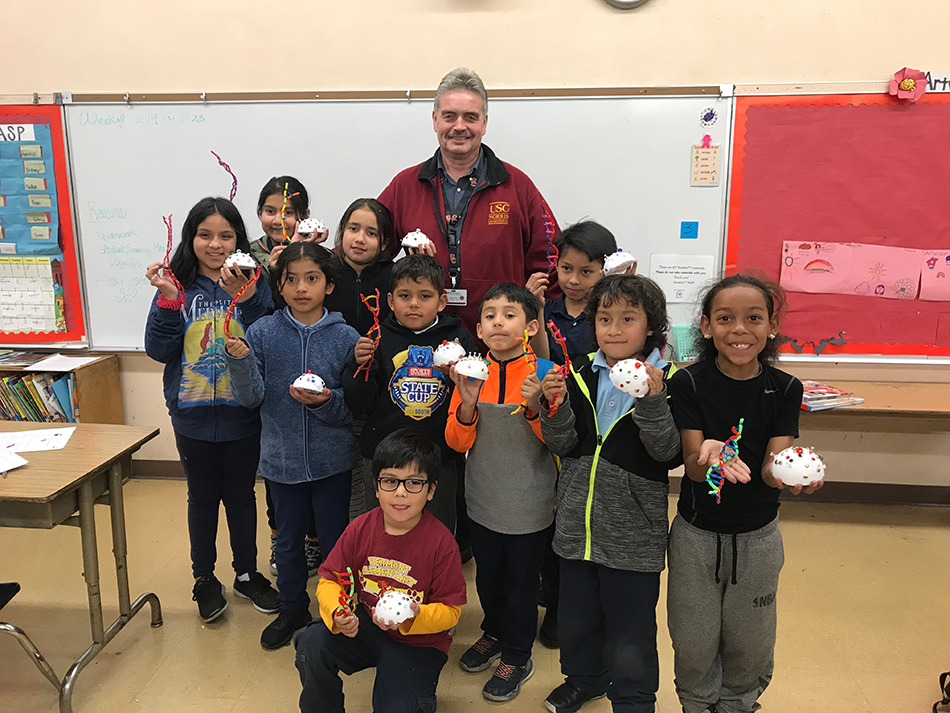
Figure 2
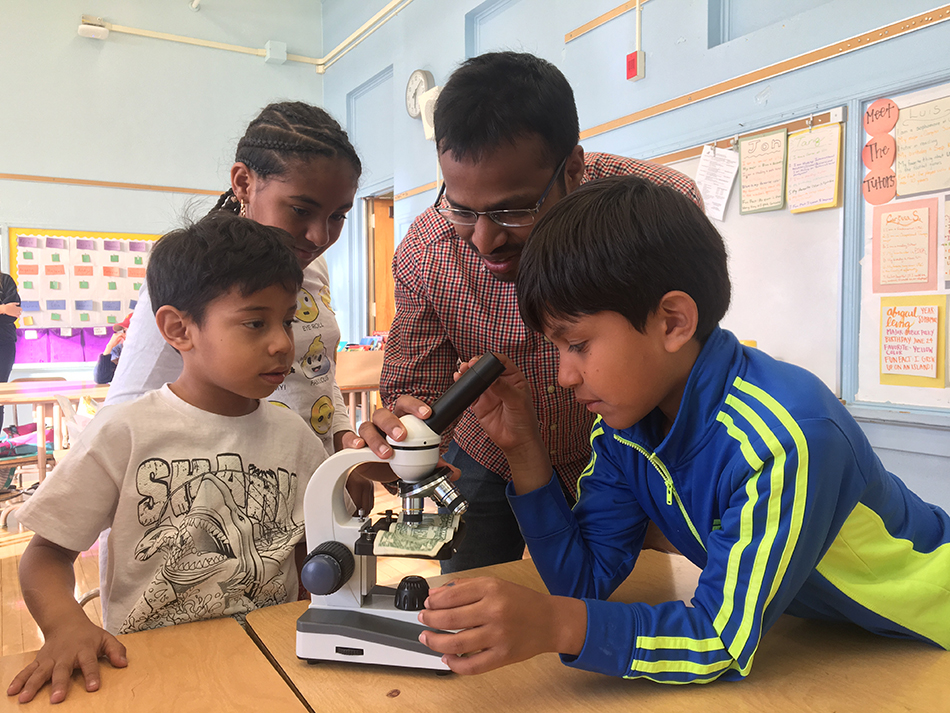
Speaker recruitment focused on inclusivity. We invited individuals from different social and cultural backgrounds, including URM groups and women in STEM in careers. The guest speakers were recruited primarily throughout the scientific community at USC and NCCC. One of the goals of introducing these diverse guest speakers is to allow students in underrepresented groups to see people who look like them succeeding in STEM fields. For the speakers who were new to the program, one-on-one training was provided to ensure their communication skills were on par with what was expected, and that they felt comfortable explaining science to the target age group. Through the program, scientists were also able to meet their mandate to educate members of the public as part of the broader impact requirements laid out in many research grants.
Wonderkids educational staff
The outreach team that participated in and assisted with the implementation of the CEPP pilot program consisted of cancer researchers and staff within NCCC, K–5 educators at the participating LAUSD schools, and undergraduate and graduate teaching staff who were trained on the CEPP curriculum. The LAUSD educators who were chosen participated as hosts for the in-school STEM programs. Their provided a different pedagogical perspective to assess whether our lessons would be age appropriate for lower elementary school students. Additionally, every undergraduate student selected to be a teaching assistant (TA) for the CEPP pilot program was provided with quality training in STEM pedagogy by credentialed faculty from USC’s Rossier School of Education. Because the CEPP curriculum was new for LAUSD educators and administrators, a training module of each module was provided to the staff facilitating the pilot program.
As outlined in Figure 3 below, four cancer-based topics were introduced to provide students with a foundational understanding of cancer biology: Oncology, Biotechnology and Cancer, the Genetics of Cancer, and Nutrition and Cancer Prevention. Each module was designed to serve as a stand-alone module, independent of the other three, and the modules can be implemented in any order. These four overarching modules communicated the science of cancer, the role of family history and genetics in cancer predisposition, some of the surgical and treatment technologies currently available, and methods for cancer prevention (see Table 1 for module alignment with the Next Generation Science Standards [NGSS Lead States 2013]).
Figure 3
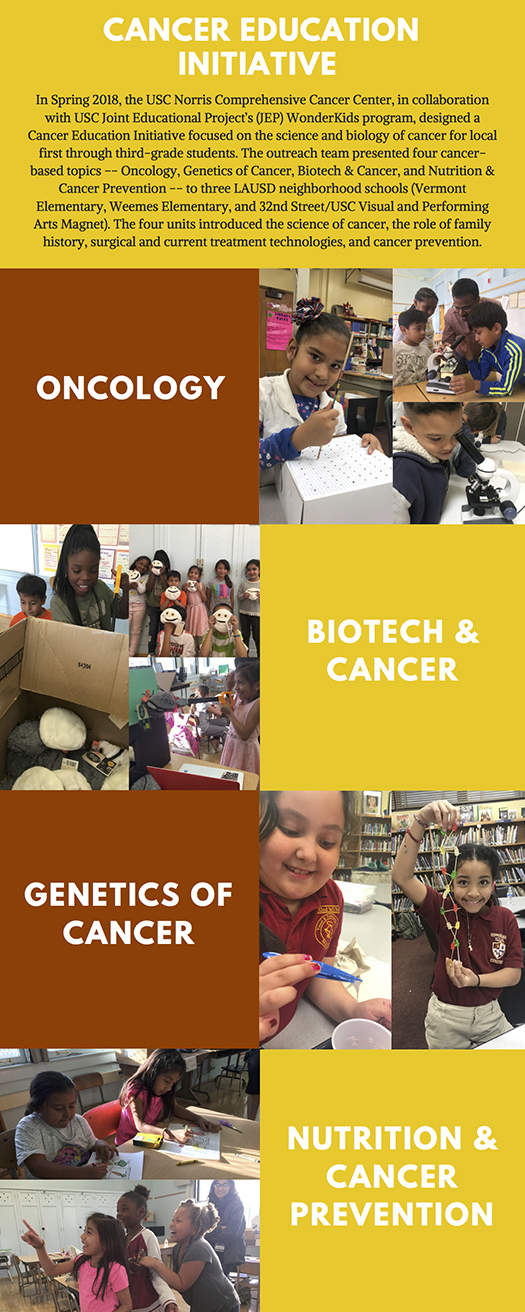
Through this implementation design, the CEPP pilot program presented cancer concepts to students in an unintimidating and highly accessible format. This format allowed for freedom to choose which major cancer concepts we exposed students to, and we wanted to beta-test which lessons would work and which would not. For example, a lesson that focused on cancer and anatomy included a pin-the-tumor-on-the-organ activity was vetoed for being too grotesque and intimidating for an elementary age group. Anupam Singh, the Wonderkids cancer education coordinator, described his initial impressions of the reception of the program: “We wanted to connect cancer education to what the kids already knew about the disease. Yes, the kids generally thought cancer was associated with illness and death, but they were very receptive to learning about the science behind the disease.”
| Grade level | NGSS Performance Expectations | Cancer-related topics |
|---|---|---|
| Kindergarten | LS1-1. Use observations to describe patterns of what animals (including humans) need to survive. | Nutrition |
| Grade 1 | 1-LS3-1. Make observations to construct an evidence-based account that young animals are like, but not exactly like, their parents. 1-LS1-2. Read text and use media to determine patterns in behavior of parents and offspring that help offspring survive. |
Genetics, DNA
Healthy lifestyle habits, nutrition, sun exposure |
| Grade 2 | K-2-ETS1-1. Ask questions, make observations, and gather information about a situation people want to change to define a simple problem that can be solved through the development of a new or improved object or tool. 2-LS4-1. Make observations of plants and animals to compare the diversity of life in different habitats. |
Biomedical engineering, biotechnology, nanotechnology
Microscopy, microbiology, environmental science |
| Grade 3 | 3-LS1-1. Develop models to describe that organisms have unique and diverse life cycles but all have in common birth, growth, reproduction, and death. 3-LS3-1. Analyze and interpret data to provide evidence that plants and animals have traits inherited from parents and that variation of these traits exists in a group of similar organisms. |
Cell division
Genetics, DNA |
| Grade 4 | 4-LS1-1. Construct an argument that animals have internal and external structures that function to support survival, growth, behavior, and reproduction. 4-PS4-1.Develop a model of waves to describe patterns in terms of amplitude and wavelength and that waves can cause objects to move. |
Vaccinations, Immunology
Cancer Treatments- Radiation & Laser Treatments |
| Grade 5 | 5-PS1-1. Develop a model to describe that matter is made of particles too small to be seen. 5-ETS1-3. Plan and carry out fair tests in which variables are controlled and failure points are considered to identify aspects of a model or prototype that can be improved. |
Cancer Treatments- Chemotherapy, Microscopy Nanotechnology, Medical Imaging, Ultrasound |
Oncology module
The Oncology module introduced the fundamental biological principles underlying cancer. The module began with a writing-based benchmark activity to assess what students already knew about cancer; these data were also used for program evaluation. The subsequent lesson featured a coloring- and counting-focused activity that allowed students to approximate the number of cells in a human body by comparing their quantities to stars, hair, and other multiplicative nouns, as seen in Figure 4. This helped students draw meaningful comparisons between the abstract concept of cancer cell proliferation and tangible examples from their surroundings. By the end of the module, students were exposed to the different types of cancer and how they affect particular organs. This lesson also provided an introduction to human anatomy through the identification of various organs that are affected by various cancer types.
Figure 4
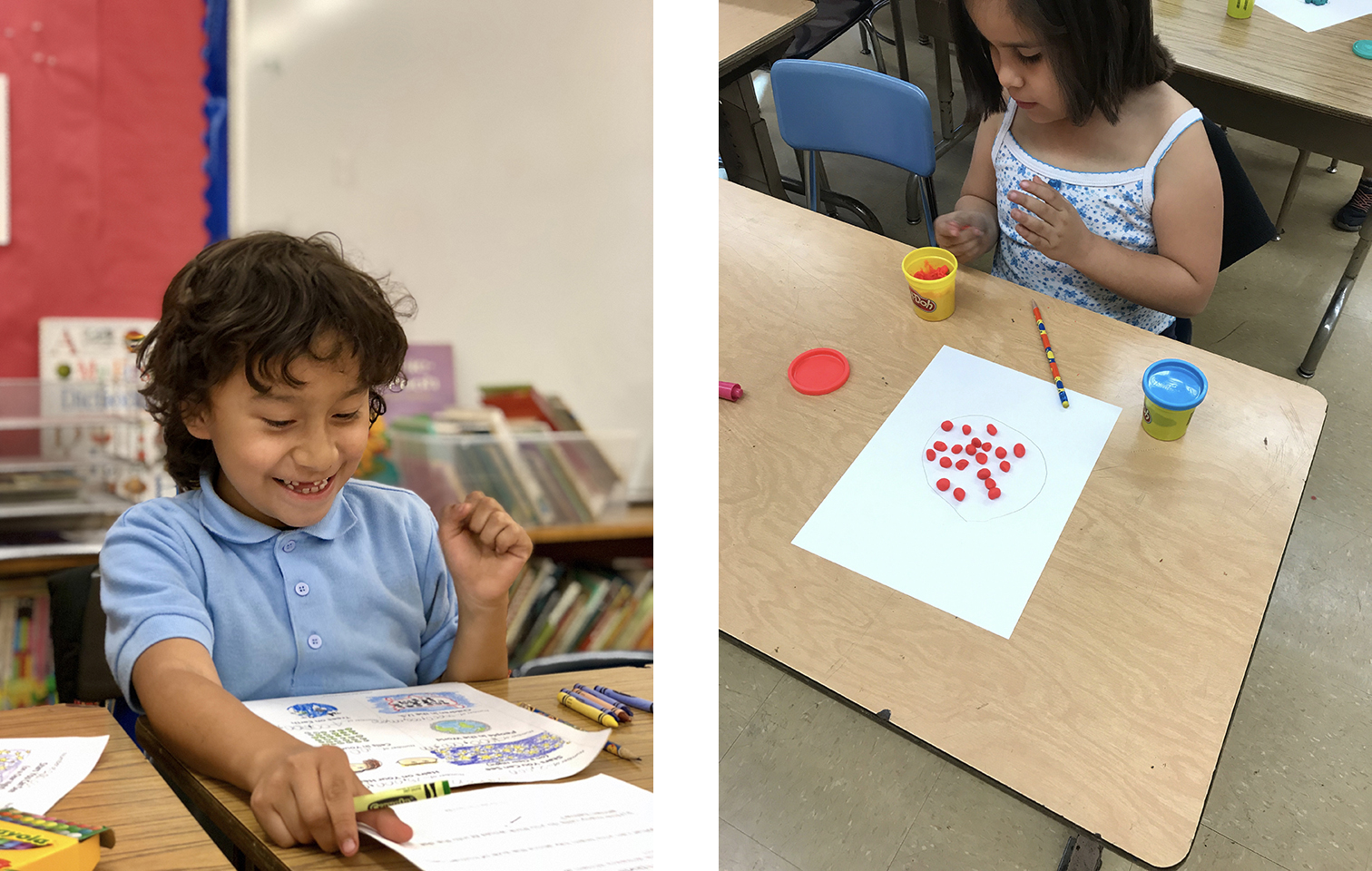
Cancer researcher Dr. W. Martin Kast, the guest speaker for the module, led a segment about defining cancer. He stated that when tumors are found in the human body, they have a distinct harder and lumpier texture compared to the surrounding soft tissue. He used a cardboard box filled with 19 defrosted ice packs and one completely frozen ice pack, as seen in Figure 5. Students felt for aberrant, dangerous “tumor” cells (the one frozen ice pack) within a matrix of healthy cells in a “body” affected by cancer (defrosted, mushy ice packs).
Figure 5
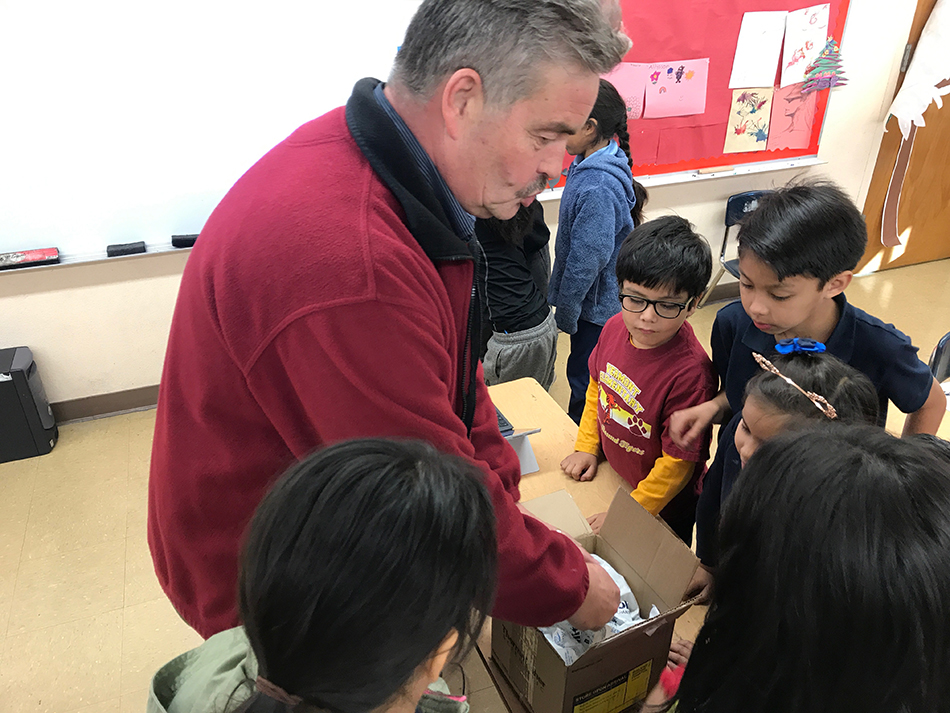
Genetics of Cancer module
The Genetics of Cancer module was designed to demonstrate to students how genetics and cancer are closely intertwined, and how the disease relies on genetic mutations to develop. The curriculum began with an introductory lesson on DNA structure to establish a foundation for the subsequent genetics lessons. In this introductory lesson, students depicted a DNA molecule by constructing a three-dimensional model using toothpicks and gummy bears. Students were thus able to recreate a double-helix string while learning the mechanics of how purines and pyrimidines come together in pairs, and how a broken toothpick in the double-helix structure represents a break in the DNA (Figure 6). After students grasped the way in which DNA is structured, they engaged in an experiment in DNA extraction using strawberries to expand on this visualization (Figure 6).
Figure 6
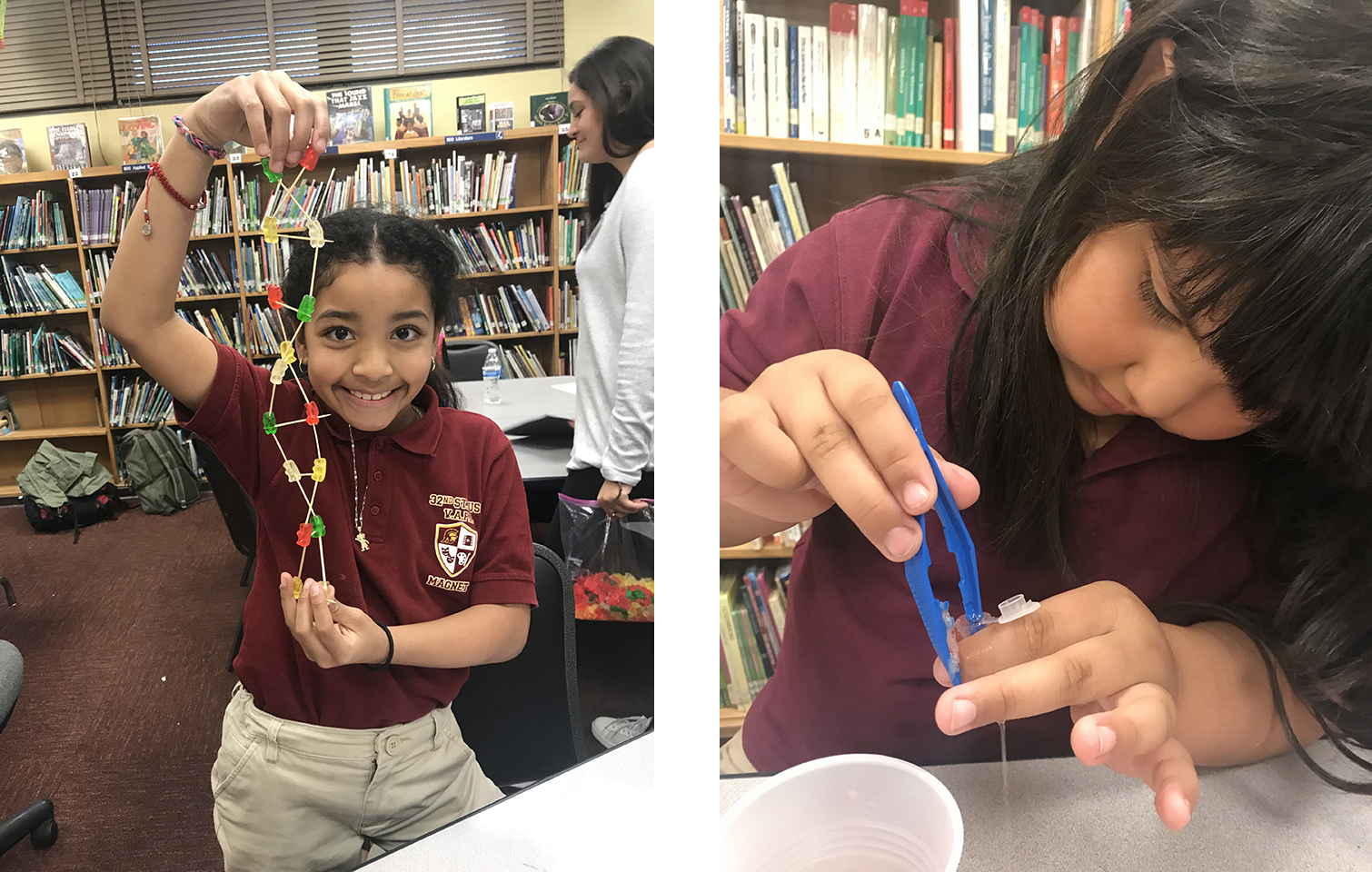
In the following lessons, students continued to build upon their knowledge of DNA structure to comprehend the functional outcomes of genetic coding. They formed evidence-based opinions on gene function through scientific experimentation on PTC paper. PTC paper is commonly used to convey the genetics of taste, as the PTC strip will either taste very bitter or virtually tasteless, depending on the genetic background of the taster. The ability to taste PTC is often considered a dominant genetic trait, although inheritance and expression of this trait are complex. Using a control strip of coffee paper and the PTC paper, students hypothesized whether they could taste bitterness based on their own eating habits, experimented on the presence of genes within their own cohort, and worked to understand how dominant and recessive traits manifest. Students tried the coffee paper first and then the PTC paper. The activity came together with a final “Trait Bingo Game,” in which students learned about their own genetic traits to complete a bingo board. The board included traits that could be identified both physically, such as detached earlobes, or family observations, such as sharing a feature with a parent. While learning about DNA during the genetics module, one of the students made a very astute and correct observation that genes provide information that can tell us a lot about ourselves as human beings.
Figure 7
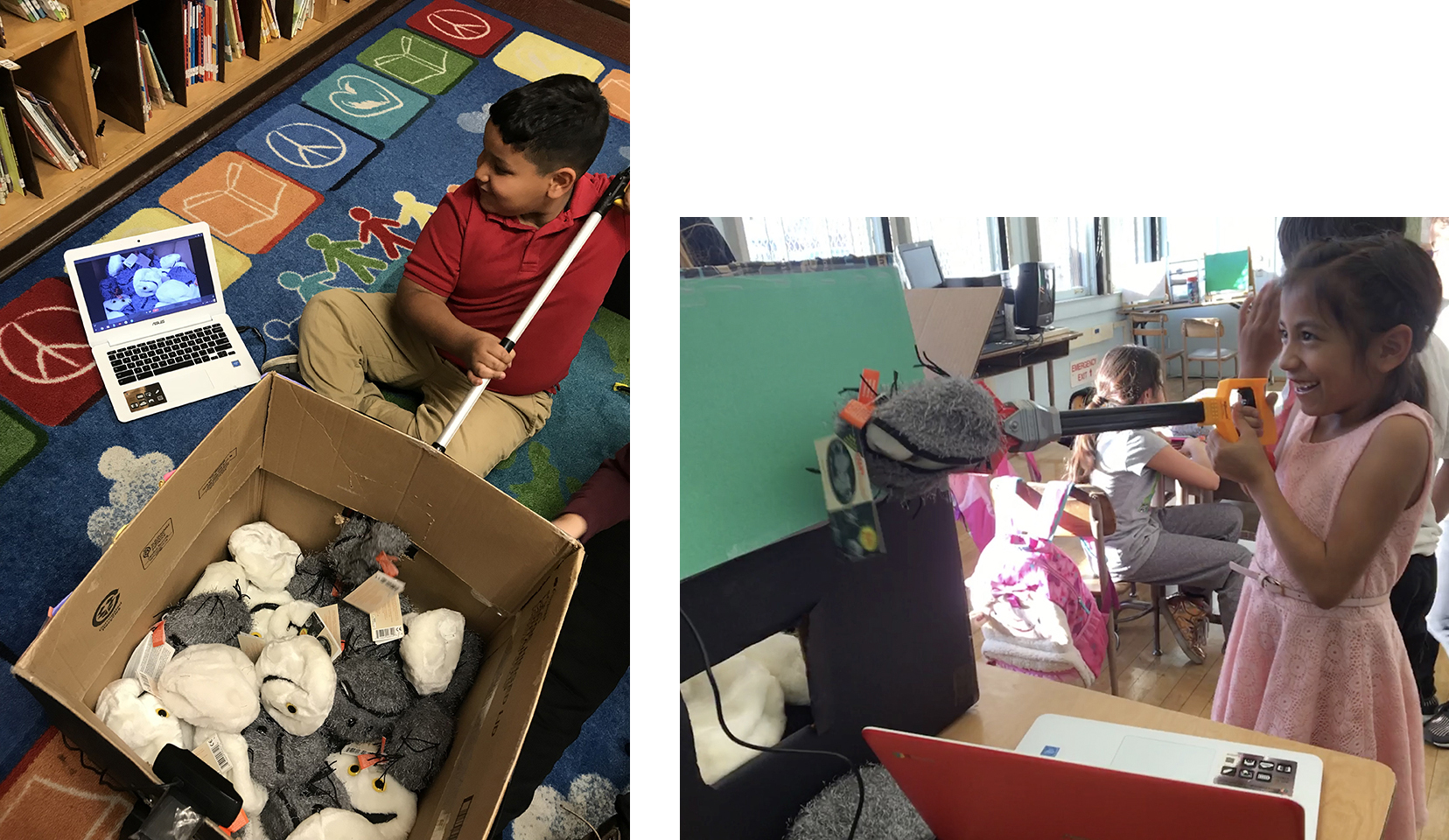
After understanding that traits are coded by our genes, students examined the genetics behind various other traits, such as eye color and hair color, and whether these are dominant or recessive traits. The module strove to foster discussion among students, who were asked to demonstrate the distinction between genetically coded traits and behaviors that are not genetically determined, but rather, predominantly shaped by the environment—in other words, the distinction between “nature” and “nurture.” The objective of this lesson was for students to understand the structure of DNA and what it tells us about our bodies, as well as how errors in DNA can ultimately result in cancer.
Biotechnology and Cancer module
The Biotechnology and Cancer module presented students with technologies used in cancer diagnosis, treatment, and prevention. Instructors simulated a tumor resection process with a makeshift robotic surgery setup that included a “human body” (cardboard box) and a mounted webcam to show them the inside of the body (Figure 7). Students needed to use pincers to manipulate what they could see on the webcam screen and distinguish healthy cells from cancer cells. Once cancer cells were identified, they were extracted. One first-grade student in particular was determined to succeed with this delicate operation. After carefully examining the gray and white cells on the monitor, he eagerly picked up his surgical tool and slowly maneuvered it with precise movements. “I got it!” he exclaimed as he proudly held up a gray cancer cell that he had captured. Caught up in the excitement of a successful surgery, he didn’t stop there. He continued to work until he had removed every single cancer cell from the body (Figure 7). Another student admirably noted how crucial it was to “protect the healthy cells” because they would “keep the body alive.”
Figure 8
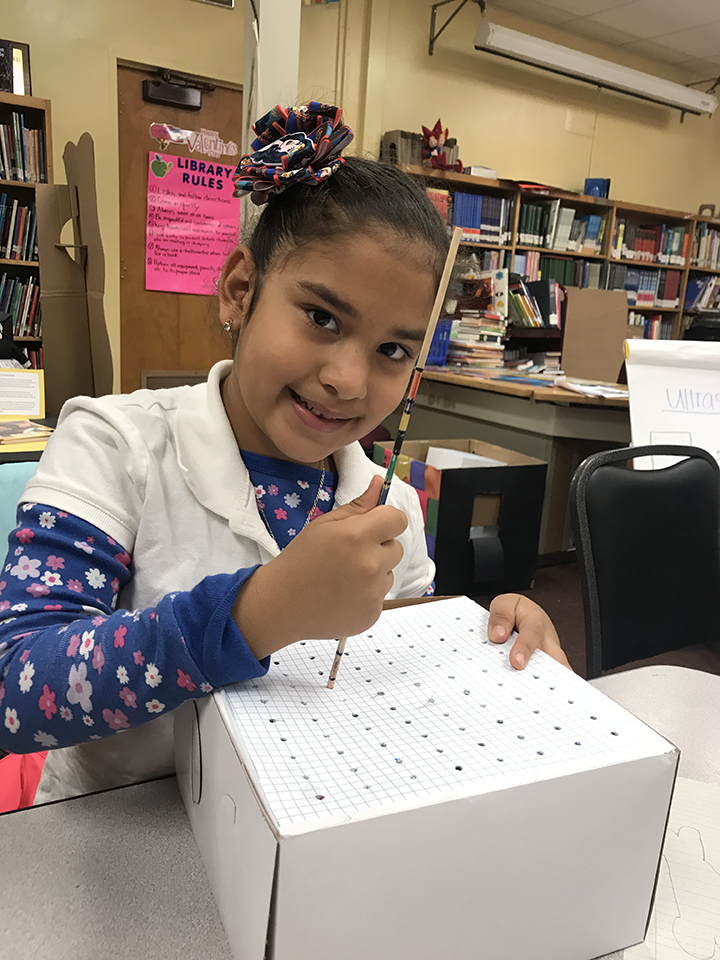
In the following lesson, students learned about various medical imaging techniques, including x-ray and ultrasound imaging. With ultrasound imaging, doctors use high-frequency sounds that are undetectable to the human ear to look inside the body. Students built their own ultrasound imaging device by relying on a bathymetry system, which uses an enclosed box with a predrawn grid of uniformly spaced holes to detect the objects inside. Students used the system to make judgements about the normality or abnormality of the objects, based on the depth at which they are detected by a probe that simulates ultrasound waves (Figure 8). Students were also taught how x-rays image bones onto ultraviolet-sensitive photographic paper to create a visual model of the human hand. X-ray imaging relies on the fact that bones are more dense than other tissue, so they successfully block x-rays and leave behind a shadow that doctors can use for diagnosis.
Figure 9
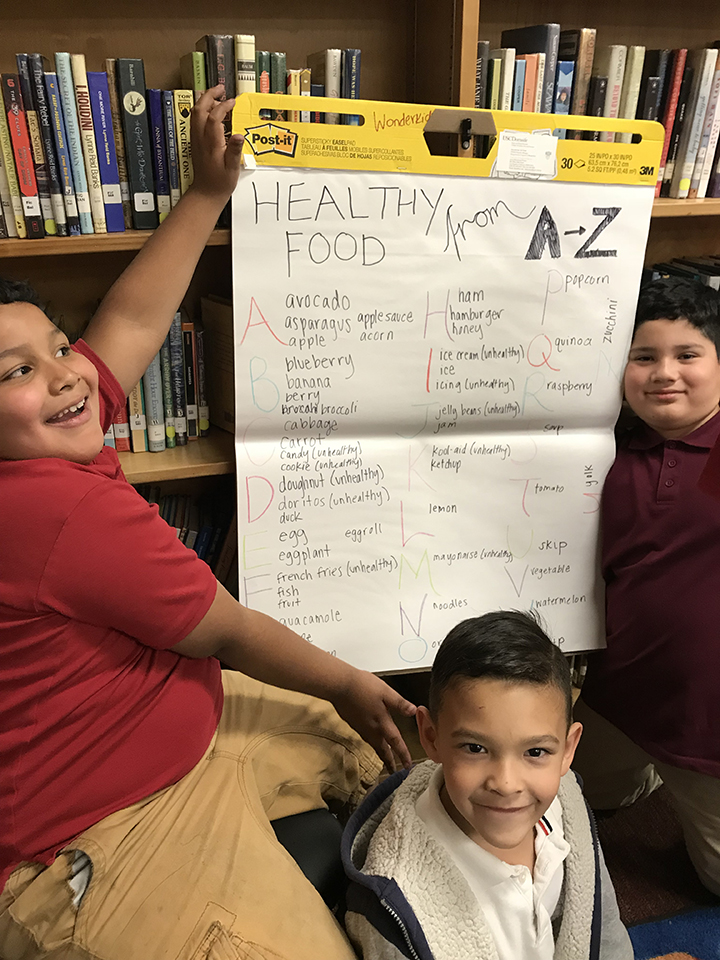
Students were also introduced to microscopes and slides. The lesson aimed to teach students about some of the many types of cells in the human body, what their normal and abnormal morphology (structure) is, and how their structure relates to cancer. Students used microscopes for an in-depth examination of different body tissues, and then illustrated their observations in drawings. In their depictions, they were able to hypothesize what those tissues would look like if they were abnormal, or cancerous. It was the first opportunity for many students to look through a microscope, and they were astounded at the many varied and interesting shapes our tissues adopt at the cellular level.
Students could then combine this knowledge with their lessons from the Oncology module to form a more nuanced understanding of what cancer does to the body. The lesson assured students that better technology allows scientists to identify cancer earlier on, and provides more specialized treatment options as a result of this early detection.
Nutrition and Cancer Prevention module
The final module featured techniques for enhanced Nutrition and Cancer Prevention. The central theme of this module borrowed from Louis Pasteur’s mantra of “prevention is better than a cure.” It taught students that many diseases, including some types of cancer, can be prevented through healthy lifestyle habits, such as eating well and maintaining a moderate level of regular physical activity. The module was presented through a series of games and activities that advocated eating well as part of a balanced lifestyle to preemptively mitigate cancer development.
Students discussed and acted out their healthy breakfast eating routines while making an alphabetical list of healthy breakfast foods. Afterward, students distinguished between a series of healthy “Go” and less healthy “Slow” breakfast foods in a variation of the popular elementary school game “Red Light/Green Light.” A final activity to really drive home the importance of healthy eating asked students to group healthy foods into colors to make an entire rainbow of healthy breakfast foods. Students gathered in a circle and the colors of this rainbow were individually called out loud. Once a color was named, students wearing that color gathered in the middle of the circle to name as many healthy breakfast foods of that color as possible. If a student on the outside had ever eaten that food for breakfast before, they were instructed to jump up and down five times to demonstrate their participation in healthy choices in an active way. When students in the middle had created an exhaustive list for that color, another color was selected (Figure 9). This process continued until all colors of the rainbow were discussed and students had a firm grasp on the colors of healthy breakfast foods. Then students were able to transform that knowledge into their own rainbow breakfast food pictures by drawing a rainbow made up of the appropriate colored food in each band (Figure 10).
Figure 10
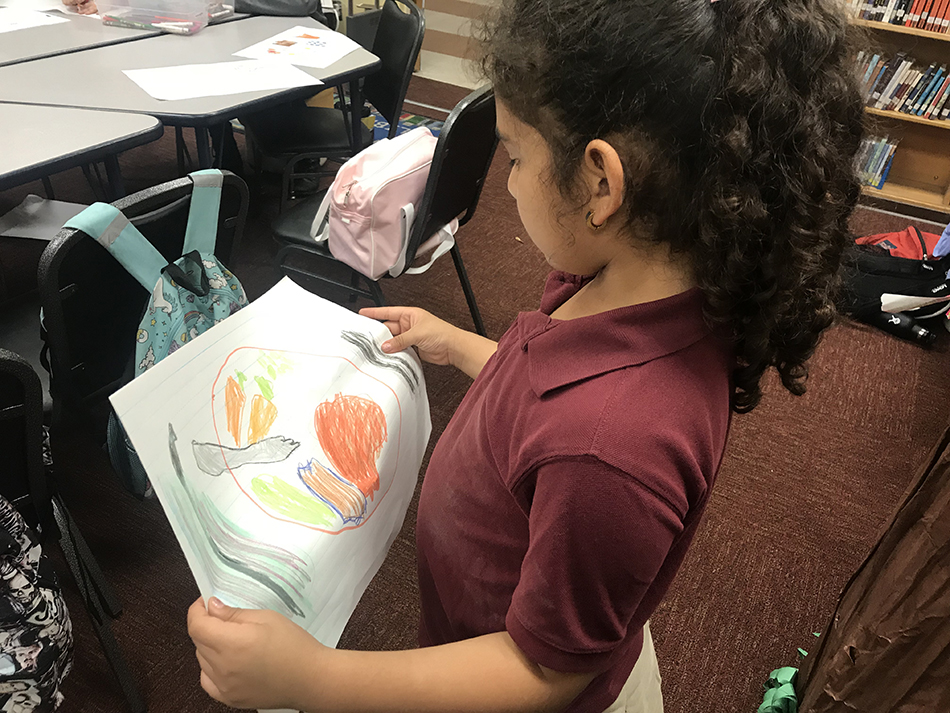
Outcomes, limitations, and preliminary data from the pilot program
Cumulatively, the program taught students about the number of cells in a human body, the process of cell division, some of the different types of cells in the body, and the key differences in cell division rates between healthy and cancer cells. The lessons set out to establish fundamental knowledge about cancer in an attempt to reduce the fear and ambiguity that surrounds it.
At the completion of this pilot study, students had been exposed to the underlying biology of cancer, the role of genetic mutations in cancer, the current technologies available in the field to identify and treat cancer, and the applicable prevention measures they can engage in now as children. The authors can all attest to just how truly inspiring it has been to witness young children (6–8 years of age) foster and articulate scientific opinions about cancer.
In a pretest (see Figure 11), students were asked what they thought and felt about cancer. Since the population of students for this pilot program is of elementary school age and has a wide range of writing and speaking abilities, worksheets that had space for writing and drawings were created for both the pre- and posttests. In the pretest, the most frequent words students associated with cancer were “sickness,” “hospital,” and generally feeling “sad.” Other responses regarding students’ knowledge and understanding of cancer ranged from “I don’t know” and “loss of hair” to “staying in the hospital.” One student thought that studying cancer would be a “cool experiment” and was visibly excited to learn more about it. Figure 12 presents word cloud summations of student responses to the pretest.
Figure 11
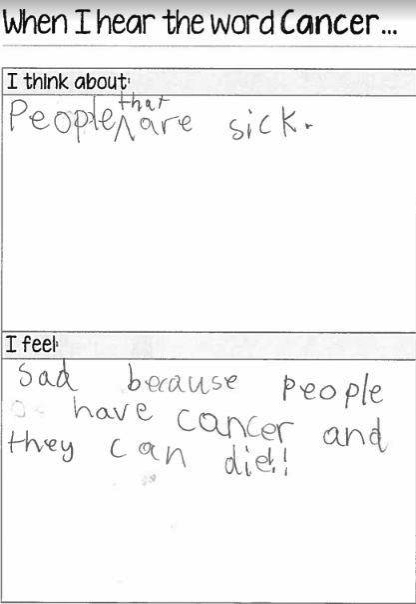
Figure 12
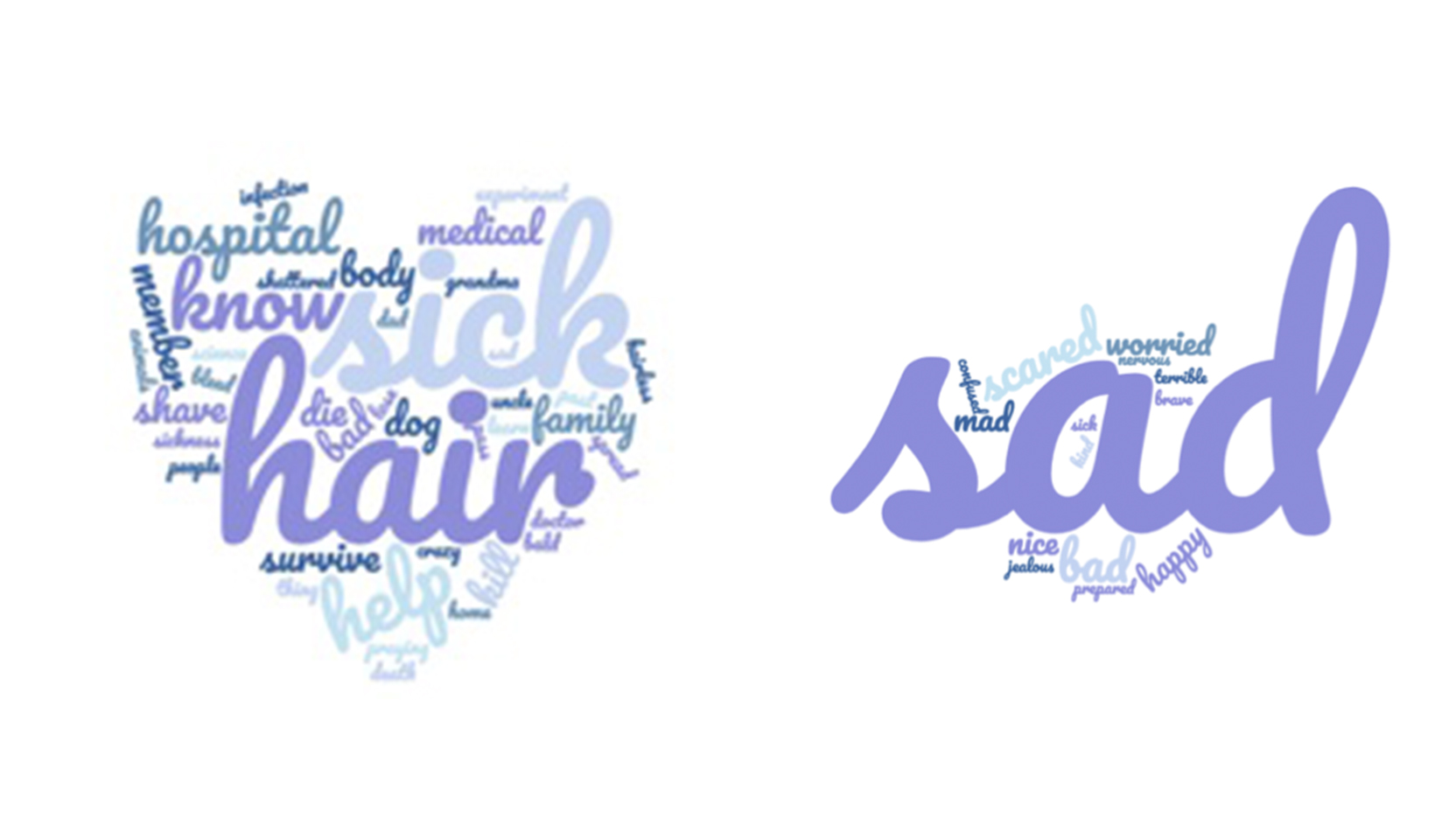
Upon completion of the pilot program, students conveyed a perceived increase in cancer awareness. Students were exposed to many different types and causes of cancer, as well as many modern treatment options that address individual patient needs. Many students expressed a desire to implement the methods of cancer prevention in their daily lives, and relay this information to their family and friends. In response to the posttest prompt, “When I hear the word cancer, I think about …,” students supplied different words and impressions than in the pretest. The word cloud from the pretest (Figure 12) is dominated by occurrences of the phrases “sick” and “hair,” whereas in the posttest word cloud (Figure 13), the predominant occurrences are “cancer,” “survive,” and “cells,” indicating a shift in student perception of cancer from an abstract, fearful topic toward a more scientific, hopeful understanding. In terms of emotion-based posttests, words such as “terrible,” “mad,” “worried,” and “nervous” no longer occurred, but words like “scared” and “sad” were still prevalent.
Figure 13
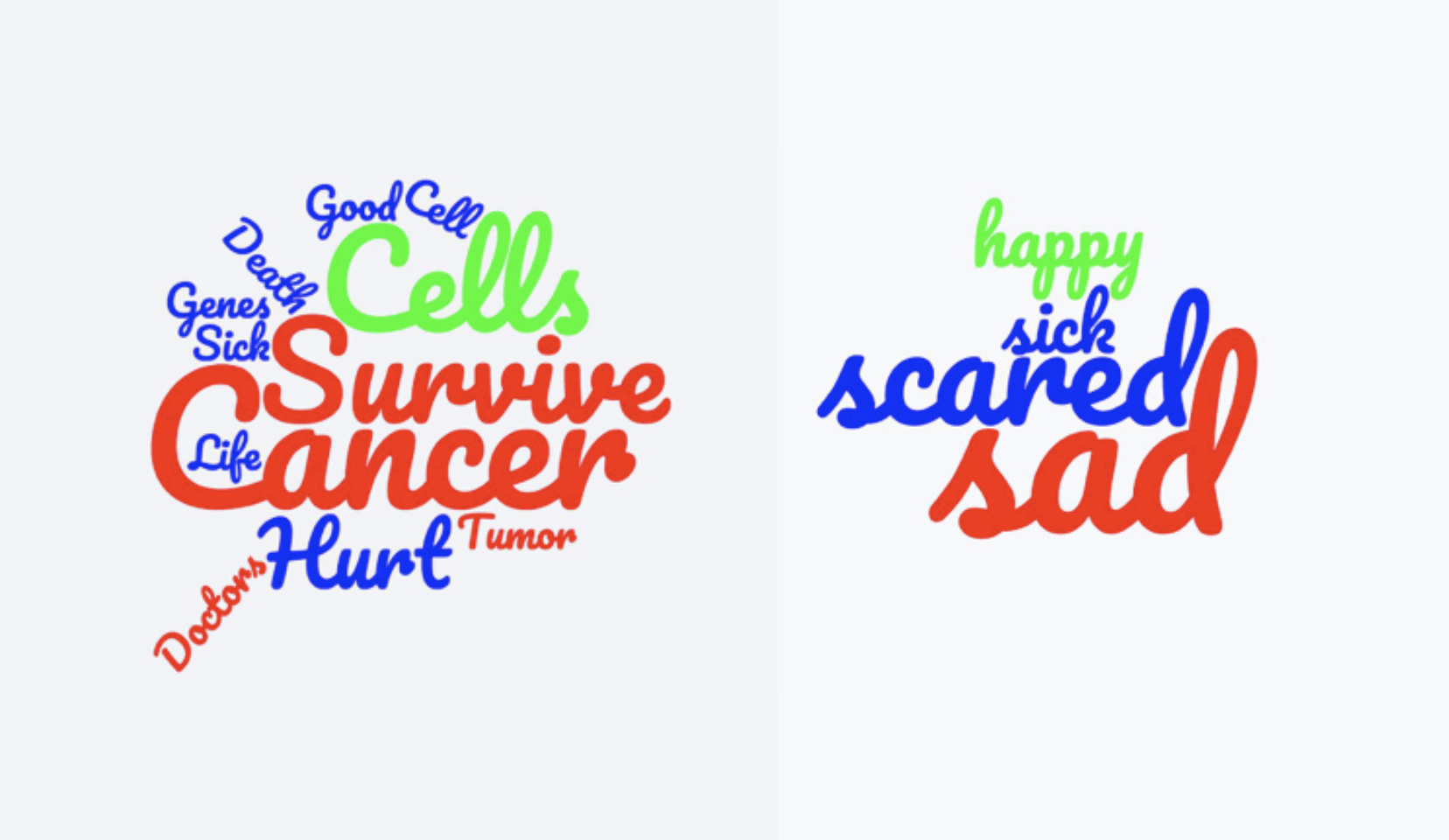
Only an informal evaluation occurred in our pilot setting. Although there was a change in the word associations from pre- to posttest, indicating a potential internalization of the lesson, a more formal evaluation of learning is needed; we plan to conduct this evaluation in the future. Another limitation is that this pilot study may not be generalizable to the entire population of elementary school students because many of the participants already have an interest in STEM (see Figure 14). (These students were already interested in STEM because they were in schools that provide an abundance of supplemental support programs in STEM.)
Figure 14
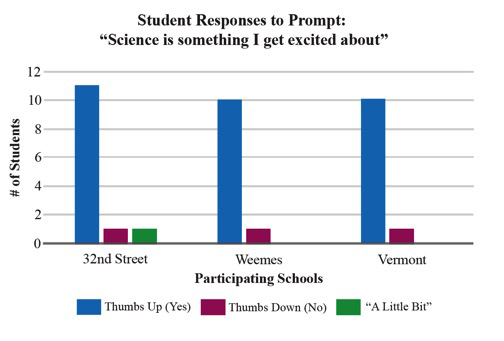
Additionally, our sample size is small. In total, 60 students were enrolled in this program; however, the science interest graph above is only from a subsection of 36 students because not all students were present on the first day of the program when this survey was administered. The next step is to conduct a formal analysis of learning outcomes and increase the sample size to more students.
Future directions for the CEPP
This article describes a pilot study used to determine the existing level of interest in cancer from students and community members and, given concerns about children’s fears, to determine whether the topic is age appropriate. The National Institutes of Health (NIH) state that science education related to health should start as early as possible (SEPA 2018). We found that students received our cancer education curriculum enthusiastically because many of them knew someone who had cancer, even though it was unclear to them what was actually happening to their family member or friend. As of this writing, the pilot program has been completed and an NIH Science Education Partnership Award (SEPA) R25 grant has been submitted to obtain funding for the full-fledged version of the program, which includes an expanded plan for both an afterschool and a during-school program. The aim is to expand this initiative into more elementary schools in the neighborhoods surrounding USC. Teachers and cancer scientists will collaborate on designing an NGSS-aligned K–5 curriculum during an upcoming planning phase for the in-school extension of the program, and these lessons will be disseminated through a professional development series for local, regional, and national educators. Table 1 summarizes which NGSS standards we have deemed most relevant to a cancer-themed project and the corresponding cancer topics the CEPP program will focus on. In addition, a formalized evaluation plan will be developed and the effectiveness of the designed education plan will be assessed on a yearly basis using parallel randomized control trials.
Acknowledgments
We thank Angeline Pan, Alexandra Stella, Surbhi Bansil, and Evan Lum for being Tas; Hinde Kast for generating the infographics; and Valerie Thomas, Katherine Dupas, Yasaman Mestchian, Dr. W. Martin Kast, Anupam Singh, Celja Uebel, Cecily Pulver, Santosh Peddi, Lisa Welter, Gina LaBeaud, Jill Patel, Sejal Mehta, Elizabeth Dunn, and Aili Vinson for serving as guest speakers. The authors would also like to thank Rita Barakat, Jessica Stellmann, Cecily Pulver, Dr. Susan Harris, and Tina Koneazny for editing this manuscript. We also thank Ilse Flores for translating the lessons into Spanish. Funding for this cancer education initiative came from the Norris Comprehensive Cancer Center through their National Institutes of Health grant (P30 CA014089).
We would also like to recognize the educators and administrative staff at Vermont Elementary School, Weemes Elementary School, and 32nd St. USC Performing Arts Magnet School for helping facilitate the lesson activities. Finally, we would like to acknowledge the significant time contributions from the JEP ReadersPlus Program.
Dieuwertje J. Kast (dkast@usc.edu) is STEM programs manager at the University of Southern California Joint Educational Project in Los Angeles, California. Anupam Singh (anupamsi@usc.edu) is Wonderkids graduate coordinator at the University of Southern California Joint Educational Project in Los Angeles, California. W. Martin Kast (Martin.Kast@med.usc.edu) is a cancer researcher at the USC/Norris Comprehensive Cancer Center.
Biology Life Science Informal Education


